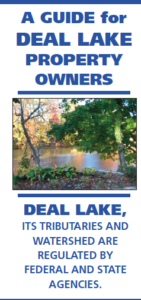Algae Bloom information
Learn more about Algae Blooms: https://www.state.nj.us/dep/wms/HABS.html
Over the past decade we have learned more about the serious health implications associated with intense cyanobacteria (bluegreen algae) blooms. Although cyanobacteria are not truly algae, these blooms are referred to as Harmful Algae Blooms (HABs). During such blooms elevated concentrations of cyanotoxins are released into the water. These toxins can cause mild to serious health consequences for humans, pets and livestock that not only ingest the water but come in contact with it.
The majority of lakes, ponds and reservoir throughout New Jersey have been subject at some time to a HAB. This includes relatively high-water quality recreational lakes and drinking water reservoirs as well as eutrophic (highly productive) waterbodies. Although these blooms are not new, we are learning more about why they occur and becoming better trained at detecting conditions indicative of a HAB.
Although a number of factors are responsible for the development of a HAB, the primary cause is too many nutrients, with elevated concentrations of phosphorus the typical trigger. In freshwater aquatic environments phosphorus is the “limiting nutrient”, meaning it is in short supply and high demand. The more phosphorus entering the environment the more productivity, with that expressed as more algae. When the conditions are correct the algal community becomes dominated by cyanobacteria. It doesn’t take much phosphorus to stimulate a bloom, as little as 0.03 part per million (PPM). Where does this phosphorus come from? The vast majority is transported by stormwater runoff from such ubiquitous sources as pet waste, fertilizers, goose droppings, septic systems, etc. This is why HAB control focuses on phosphorus management, with prioritization given to controlling the amount and quality of stormwater entering our lakes, ponds and reservoirs.
NJDEP has become increasingly attune to HABs and has taken steps to protect the public from the potential health issues resulting from these blooms. However, what is lacking at this time in New Jersey is an established protocol for the sampling of HABs and a specific water quality standard to issue warnings and closures. This would be akin to the protocols and standards used to sample and close waterbodies to contact recreation based on elevated concentrations of E. coli or fecal coliform. In 2015 and 2016 the USEPA published user guidelines for cyanotoxins measured in both drinking water and recreational water. Similar to NJDEP, the New York State Department of Environmental Conservation also tracks HABs and issues warnings and closures. The difference though it is that New York follows a well-defined protocol and has promulgated actual cyanotoxin standards that are used to determine when the public is at risk. For example, in the case of recreational lakes (swimming, boating, etc.) the public is issued a warning by the NYSDEC when cyanotoxin concentrations (reported as microcystin) exceeds 4 µg/L. Subsequently, a lake will be closed to recreational use if the concentration of microcystin exceeds 20 µg/L. Just this year, recognizing the severity of HABs and its impacts to drinking water and recreational waterbodies, New York appropriated $65,000,000 for HAB management and increased their State-wide monitoring of the occurrence of HABs and the reporting of HAB warnings and closures.
Such a definitive approach is needed in New Jersey and should be adopted sooner than later. What is also needed is more funding dedicated to the protection and management of our critically important lakes, ponds and reservoir, which not only provide valuable and economically important year-round recreation, but are major sources of drinking water, especially for northern New Jersey. What we also need is more attention and funding directed to stormwater management. This includes source control (that is, keeping as much phosphorus and nitrogen as possible out of aquatic ecosystems) and stormwater management that reduces the volume and improves the quality of runoff released to streams, rivers, reservoirs, ponds and lakes. It also means better compliance with existing MS4 regulations and more effort by individuals to pick up after their dog, forego feeding the geese and reduce the amount of fertilizer applied to lawns.
Although our awareness of HABs is increasing, cyanobacteria and cyanotoxins have been around for millennia. As noted, numerous studies link increasing nutrient levels to HAB development. This is something that can be controlled. It is ultimately up to us to us to lessen the occurrence of HABs through better stormwater management and lessened nutrient loading. In the meantime we also need NJDEP to formulate and implement a more definitive HAB monitoring and reporting program that is based on the actual measurement of cyanotoxins, similar to what is done in New York and recommended by the USEPA.
Stephen J. Souza, Ph.D.
Founder, Princeton Hydro, LLC
Dr. Stephen Souza is the Founder or Princeton Hydro, LLC, a science and engineering consulting company that is committed to changing our ecosystems, quality of life, and communities for the better. Princeton Hydro is the recognized regional leader in the management and restoration of lakes, ponds and reservoirs. Dr. Souza is a past president of the Pennsylvania Lake Management Society and the North American Lake Management Society. He was the 2012 recipient of the NJ-AWRA Peter J. Homack Award, the 2017 NALMS Lake Management Success Story award recipient and the 2018 New York State Federation of Lakes Lake Tear of the Clouds Life Time Achievement Award. He is actively involved in the New Jersey Coalition of Lakes Association and teaches continuing education courses for Rutgers in lake management and restoration and pond management. He can be contacted via email at .
![]()

